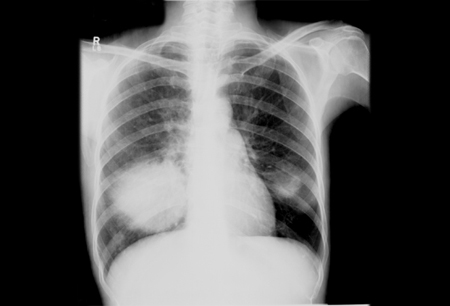Resumo
Definição
História e exame físico
Principais fatores diagnósticos
- presença de fatores de risco
- sintomas constitucionais
- dispneia
- tosse produtiva
- macicez à percussão
- murmúrio vesicular diminuído
- estertores
- cefaleia
- alteração da consciência
- irritação meníngea
- papiledema
- lesões cutâneas
- coma
Outros fatores diagnósticos
- dor torácica
- neuropatia craniana
- manifestações oculares
Fatores de risco
- Infecção pelo vírus da imunodeficiência humana (HIV)
- imunossupressão
- exposição a espécies de Cryptococcus
- sexo masculino
- gestação e período pós-parto
Investigações diagnósticas
Primeiras investigações a serem solicitadas
- antígeno polissacarídeo criptocócico (CrAg) sérico
- antígeno polissacarídeo criptocócico (CrAg) no líquido cefalorraquidiano (LCR)
- antígeno polissacarídeo criptocócico (CrAg) no líquido pleural
- culturas
- anticorpos antivírus da imunodeficiência humana (anti-HIV)
- radiografia torácica
- punção lombar
- microscopia do líquido cefalorraquidiano (LCR)
- contagem de leucócitos (células/microlitro) no líquido cefalorraquidiano (LCR)
Investigações a serem consideradas
- tomografia computadorizada (TC) do tórax
- ressonância nuclear magnética (RNM) cerebral
- TC cranioencefálica
- broncoscopia
- biópsia
Novos exames
- reação em cadeia da polimerase para criptococos
Algoritmo de tratamento
sem HIV
com vírus da imunodeficiência humana (HIV)
Colaboradores
Autores
Radha Rajasingham, MD
Associate Professor of Medicine
Infectious Diseases and International Medicine
Department of Medicine
University of Minnesota
Minneapolis
MN
Declarações
RR receives grants from the US National Institutes of Health (NIH) for prevention of cryptococcal meningitis clinical trials. She is a consultant for the Pan American Health Organization for research in histoplasmosis screening. RR is an author of several references cited in this topic.
Agradecimentos
Dr Radha Rajasingham would like to gratefully acknowledge Dr David Boulware, Dr Renata L. Riha, and Dr Athanasia D. Pataka, previous contributors to this topic.
Declarações
DRB has received research support from Gilead. RLR and ADP declare that they have no competing interests.
Revisores
William Powderly, MD
Professor of Medicine
Washington University in St Louis
St Louis
MO
Declarações
WP declares that he is a member of advisory boards for Gilead and Merck and his institution has received research grants from Merck; none of these are related to antifungal therapy. WP is a member of the Board of Directors (Past President) of the Infectious Diseases Society of America. WP is an author of a reference cited in this topic.
Ricardo Negroni, MD
Consultant
Muñiz Hospital
Honorary Professor
University of Buenos Aires
Buenos Aires
Argentina
Declarações
RN declares that he has no competing interests.
Aimee Zaas, MD, MHS
Assistant Professor of Medicine
Division of Infectious Diseases and International Health
Duke University Medical Center
Durham
NC
Declarações
AZ has received research funding from Enzon Pharmaceuticals and has been on the speaker's bureau for Astellas Pharma and Pfizer Inc.
Joseph Jarvis, BSc, MBBS, MRCP
Professor
Department of Clinical Research
Faculty of Infectious and Tropical Diseases
London School of Hygiene and Tropical Medicine
London
UK
Declarações
JJ declares that he has no competing interests.
Créditos aos pareceristas
Os tópicos do BMJ Best Practice são constantemente atualizados, seguindo os desenvolvimentos das evidências e das diretrizes. Os pareceristas aqui listados revisaram o conteúdo pelo menos uma vez durante a história do tópico.
Declarações
As afiliações e declarações dos pareceristas referem--se ao momento da revisão.
Referências
Principais artigos
Chayakulkeeree M, Perfect JR. Cryptococcosis. Infect Dis Clin North Am. 2006 Sep;20(3):507-44. Resumo
Panel on Opportunistic Infections in HIV-Infected Adults and Adolescents. Guidelines for the prevention and treatment of opportunistic infections in adults and adolescents with HIV: cryptococcosis. Oct 2024 [internet publication].Texto completo
World Health Organization. Guidelines for diagnosing, preventing and managing cryptococcal disease among adults, adolescents and children living with HIV. Jun 2022 [internet publication].Texto completo
Perfect JR, Dismukes WE, Dromer F, et al. Clinical practice guidelines for the management of cryptococcal disease: 2010 update by the Infectious Diseases Society of America. Clin Infect Dis. 2010 Feb 1;50(3):291-322.Texto completo Resumo
Boulware DR, Meya DB, Muzoora C, et al. Timing of antiretroviral therapy after diagnosis of cryptococcal meningitis. N Engl J Med. 2014 Jun 26;370(26):2487-98.Texto completo Resumo
Rolfes MA, Hullsiek KH, Rhein J, et al. The effect of therapeutic lumbar punctures on acute mortality from cryptococcal meningitis. Clin Infect Dis. 2014 Dec 1;59(11):1607-14.Texto completo Resumo
Artigos de referência
Uma lista completa das fontes referenciadas neste tópico está disponível para os usuários com acesso total ao BMJ Best Practice.

Diagnósticos diferenciais
- Tuberculose
- Neoplasia primária ou metastática do sistema nervoso central (SNC)
- Manifestações cutâneas das infecções sistêmicas
Mais Diagnósticos diferenciaisDiretrizes
- Global guideline for the diagnosis and management of cryptococcosis
- Guidelines for the prevention and treatment of opportunistic infections in adults and adolescents with HIV: cryptococcosis
Mais DiretrizesVideos
Punção lombar diagnóstica em adultos: demonstração animada
Mais vídeosConectar-se ou assinar para acessar todo o BMJ Best Practice
O uso deste conteúdo está sujeito ao nosso aviso legal